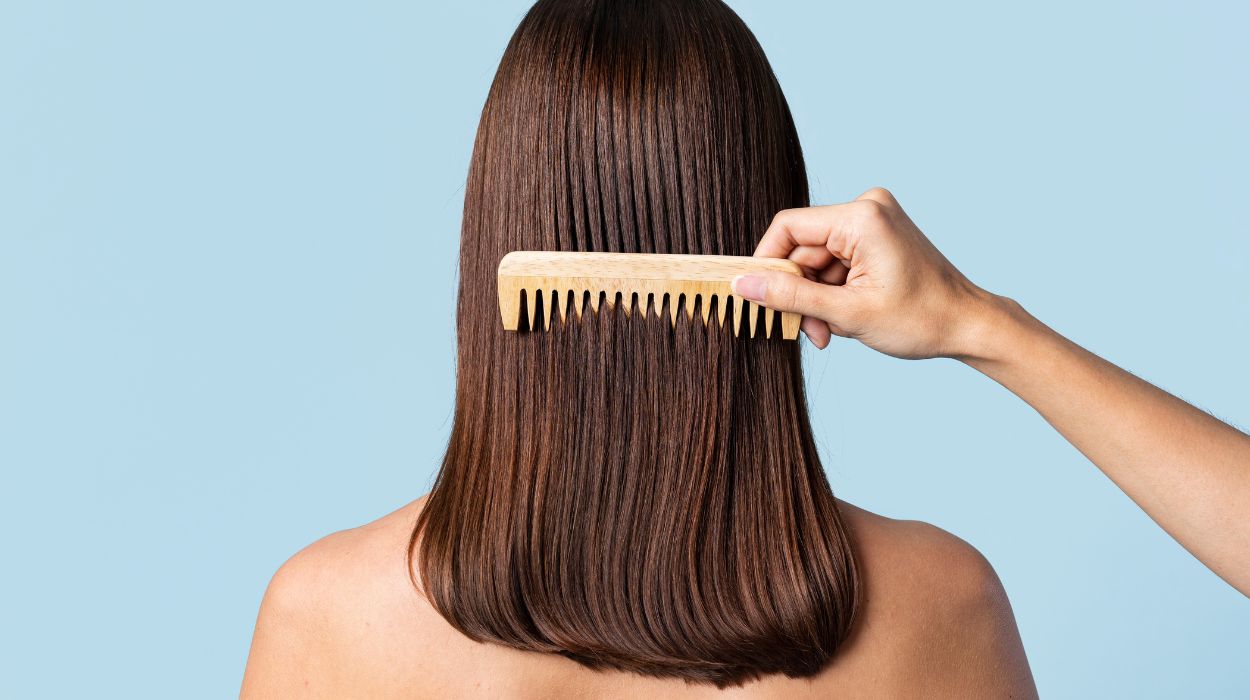 Expert's opinion
Expert's opinion
Expert's opinion
The article is a subjective view on this topic written by writers specializing in medical writing.
It may reflect on a personal journey surrounding struggles with an illness or medical condition, involve product comparisons, diet considerations, or other health-related opinions.
Although the view is entirely that of the writer, it is based on academic experiences and scientific research they have conducted; it is fact-checked by a team of degreed medical experts, and validated by sources attached to the article.
The numbers in parenthesis (1,2,3) will take you to clickable links to related scientific papers.
How To Get Rid Of Static In Hair: 6 Effective Ways To Follow In 2024

Static hair is a common issue that can be frustrating, especially during dry winter. When there is not enough moisture in the air, electrons can build up on the hair, creating a static charge that makes it stand up and hard to manage. Fortunately, there are several hair products, tips, and tricks to get rid of static in hair and keep your hair smooth and frizz-free.
Key Takeaways
- Static electricity is an electrical charge that builds up on the surface of a material or object such as hair.
- Hair has a very high water content[1] of about 14% by weight at normal conditions like 20°C weather and 65% relative humidity. However, the amount of water in hair can vary depending on factors such as the humidity and temperature of the surrounding environment
- Dryness, friction, synthetic fabrics, temperature changes, and humidity can cause hair to become staticky.
- To prevent static in hair, you can use hair products[2] with hydrating ingredients, switch to a wooden comb, sleep on silk pillowcases, use an ionic hair dryer, and wear clothing made from natural fibers like cotton, wool, or silk.
How To Get Rid Of Static In Hair?

Here are six tips and tricks for people who want to learn how to get static out of hair.
Use A Leave-in Conditioner
Using a hair conditioner[3] can help hair that is prone to static. If you have dry hair, it is more susceptible to static, but a leave-in conditioner adds moisture to your hair, which helps to reduce static electricity.
In addition, leave-in conditioners contain ingredients that can smooth the hair, reducing friction and static electricity. This smoothing effect can also make the hair look shinier and healthier.
These kinds of hair products[4] may have some additives to improve your hair health, such as protecting the hair from damage caused by heat styling, chemical treatments, and environmental factors. Healthy hair is less prone to static electricity, so a leave-in conditioner can prevent further damage.
In addition, these smoothing effects also help to detangle your hair. Tangled hair is more likely to develop static electricity. However, a leave-in conditioner can help to detangle the hair, making it easier to manage and less prone to static.
Switch To A Wooden Comb
Wooden combs are gentle on the hair and scalp. They have smooth teeth that glide through the hair without snagging or pulling, which can reduce breakage and static. Unlike plastic combs, wooden combs do not produce static electricity, which can contribute to frizz and flyaways.
Moreover, wooden combs are eco-friendly and sustainable. They are made from renewable resources and are biodegradable, unlike plastic combs that can take hundreds of years to decompose. Using a wooden comb is a small step towards reducing plastic waste and protecting the environment.
Use A Silk Pillowcase
Silk pillowcases can also help to reduce static electricity in the hair. Silk is a natural fiber that does not produce static electricity, unlike synthetic materials like polyester or nylon. Sleeping on a silk pillowcase can help to prevent friction between the hair and pillowcase, reducing static and tangles.
Use An Ionic Hair Dryer And Dryer Sheets
Ionic hair dryers use negative ions on the hair surface, reducing drying time and frizz. This helps to prevent static electricity by reducing the buildup of static charges in the hair. Negative ions work by neutralizing the positive charges that cause static electricity, resulting in smoother, shinier, and more manageable hair.
Using an ionic hair dryer can help lock in moisture and prevent dryness. This can help to reduce static electricity by keeping the hair hydrated and healthy.
When using an ionic hair dryer, it’s important to use it correctly to get the best results. Start by using a heat protectant spray on the hair to protect it from heat damage. Then, use the lowest heat setting that works for your hair type, and keep the dryer at a safe distance from the hair to avoid overheating or burning.
It’s also important to avoid over-drying the hair, as this can lead to dryness and damage that can cause static.
Also, you can try using dryer sheets containing a thin layer of fabric softener that can help to reduce static electricity in the hair. Rubbing a dryer sheet over your hair can neutralize the static charge and prevent frizz and flyaways. However, be careful not to use too much or rub too vigorously, as this can cause product buildup on the hair.
Use Anti-Static Products For Hair

An ideal hair care product[5] should be able to hold water and neutralize the static electricity of the hair.
Hair Serums
Hair serums are oils[6] or liquids that are designed to smooth the hair and provide nourishment. Hair products can also help to remove static electricity by coating the hair with a protective layer that helps to neutralize static charges. You can use hair serums that contain ingredients like argan oil, coconut oil, or jojoba oil, which can help to soften and nourish the hair. Or you can directly use these oils in small amounts.
Anti-static Sprays
Anti-static sprays are designed to be applied to the hair to neutralize static charges and prevent frizz and flyaways. They can be applied to dry hair throughout the day as needed and can be particularly helpful in dry or static-prone environments.
Wear Natural Fibers
Choosing the right fabrics can also help manage your static hair. Natural fibers like cotton, silk, and wool are less likely to contribute to static electricity than synthetic fabrics like polyester or nylon.
What Is Static?
Static electricity is an electrical charge that builds up on the surface of a material or object. It occurs when there is an imbalance of positive and negative charges in an object, resulting in an electrical charge that remains static or stationary on the object’s surface.
When two objects with opposite electrical charges come into contact or are separated, a static electric discharge, commonly known as a spark, can occur. In hair, static hair occurs because static electricity can cause hair strands to repel each other, resulting in flyaways and frizz.
Why Is Hair So Staticky?
How to get rid of static hair? Hair becomes staticky when there is an imbalance of electrical charges on the hair strands. This is caused by a few different factors:
- Dryness: When hair is dry, it loses moisture and natural oils that help to keep it smooth and static-free. This lack of moisture makes the hair more likely to develop an electrical charge, leading to static.
- Friction: When hair is brushed or rubbed against clothing, it creates friction, leading to an electrical charge building up on the hair strands.
- Synthetic fabrics: Synthetic fabrics like polyester and nylon are known to create more static than natural fibers like cotton and wool. When hair comes into contact with synthetic fabrics, it is more likely to become staticky.
- Temperature changes: When hair is exposed to rapid changes in temperature, such as going from a warm room to a cold outside environment, it can create an electrical charge on the hair strands.
- Humidity: Humidity levels can also affect the electrical charge of hair. When there is high humidity, the excess moisture in the air can help to neutralize any electrical charges on the hair, making it less likely to become staticky.
Other Ways To Prevent Static Hair
How to get rid of hair static? After following the steps mentioned above, you can benefit from some other solutions too. Here are some other ways to avoid static hair:
- You can keep your hair hydrated by using a moisturizing shampoo in addition to a moisturizing conditioner.
- You can include vitamin and mineral sources into your diet that can contribute to fine hair health.
- You can try using a humidifier in your home during dry winter months especially if the place where you live has very dry weather, to add moisture to the air and prevent static.
- Staticky, dried hairs are more open to breakage. Therefore, avoiding over-styling your hair with heat tools like straighteners and curling irons will benefit frizzy hair, as these can dry out your hair and cause static.
- Brushing your hair too much causes friction and leads to static, so you shouldn’t brush your hair too much.
Conclusion
How to get rid of static in your hair? Static hair can be a frustrating problem, but it can be prevented by understanding the underlying causes. Dryness, friction, synthetic fabrics, temperature changes, and humidity all contribute to the buildup of electrical charges on the hair strands, resulting in static.
However, you can take many simple steps to prevent static hair. Using conditioners, hair serums, oils, and anti-static sprays, along with using an anionic hair dryer, wearing natural fibers, using a silk pillowcase, and switching from plastic to wooden combs can all help diminish the frizz problem.
+ 6 sources
Health Canal avoids using tertiary references. We have strict sourcing guidelines and rely on peer-reviewed studies, academic researches from medical associations and institutions. To ensure the accuracy of articles in Health Canal, you can read more about the editorial process here
- Groves, P., Marsh, J.M., Sun, Y., Chaudhary, T. and Chechik, V. (2018). Effect of humidity on photoinduced radicals in human hair. Free Radical Biology and Medicine, [online] 121, pp.20–25. doi:https://doi.org/10.1016/j.freeradbiomed.2018.04.548.
- Gavazzoni Dias, M.F. (2015). Hair cosmetics: An overview. International Journal of Trichology, [online] 7(1), p.2. doi:https://doi.org/10.4103/0974-7753.153450.
- Rathi, S. and D′Souza, P. (2015). Shampoo and conditioners: What a dermatologist should know? Indian Journal of Dermatology, [online] 60(3), p.248. doi:https://doi.org/10.4103/0019-5154.156355.
- Madnani, N. and Khan, K. (2013). Hair cosmetics. Indian Journal of Dermatology, Venereology, and Leprology, [online] 79(5), p.654. doi:https://doi.org/10.4103/0378-6323.116734.
- Zhou, Z., Xu, J., Zhu, S., Yu, W., Li, J., Li, J., Wang, B. and Chen, K. (2022). A design with natural polysaccharide particles and cationic conditioning agent as efficient emulsifier for hair care. Carbohydrate Polymers, [online] 286, p.119311. doi:https://doi.org/10.1016/j.carbpol.2022.119311.
- Arghya, A. and Mysore, V. (2022). Hair oils: Indigenous knowledge revisited. International Journal of Trichology, [online] 14(3), p.84. doi:https://doi.org/10.4103/ijt.ijt_189_20.



